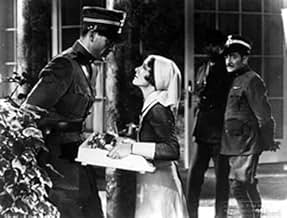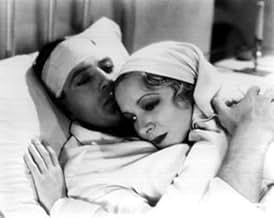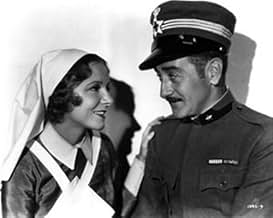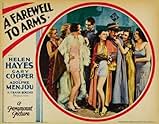PUNTUACIÓN EN IMDb
6,4/10
7,3 mil
TU PUNTUACIÓN
El conductor de una ambulancia estadounidense y una enfermera inglesa se enamoran en Italia durante la Primera Guerra Mundial.El conductor de una ambulancia estadounidense y una enfermera inglesa se enamoran en Italia durante la Primera Guerra Mundial.El conductor de una ambulancia estadounidense y una enfermera inglesa se enamoran en Italia durante la Primera Guerra Mundial.
- Dirección
- Guión
- Reparto principal
- Ganó 2 premios Óscar
- 7 premios y 2 nominaciones en total
Alice Adair
- Cafe Girl
- (sin acreditar)
Henry Armetta
- Bonello
- (sin acreditar)
Herman Bing
- Swiss Postal Clerk
- (sin acreditar)
Agostino Borgato
- Giulio
- (sin acreditar)
Robert Cauterio
- Gordini
- (sin acreditar)
Marcelle Corday
- Swiss Nurse
- (sin acreditar)
Gino Corrado
- Italian Soldier
- (sin acreditar)
Peggy Cunningham
- Molly
- (sin acreditar)
George Humbert
- Piani
- (sin acreditar)
William Irving
- Frustrated Opera Singer
- (sin acreditar)
Reseñas destacadas
This story about a doomed love affair during the Italian campaign of WWI results to be the original and the best film version of Ernest Hemingway's novel. It deals with an American soldier, Gary Cooper, and a good English nurse, Helen Hayes, both of whom fall in love on the Italian front during WWI. He is an ambulance driver while braverly risking his life in the line of duty he is wounded and ends up in the hospital where he falls for the attending nurse who is caring him. In the midst of war the intimate pair of lovers fight to stay together and to survive the massacres around them. At the end Austria capitules and armistice is declared. Let's love tonight she said, there may be no tomorrow. Every woman who has loved will understand.
Sensitive and romantic story about a deep and thunderous love story set in the horrors of the WWI when were developing the bloody battles of Marne and Piave. However, the novelist Hemingway disavowed the ambiguous final, but the public all around the world loved the movie. Both protagonists, Gary Cooper and Helen Hayes give awesome acting in one of the great love stories of all time. They are finely accompanied by a nice support cast at the time, such as : Adolphe Menjou, Jack La Rue, Mary Philips, Mary Forbes, among others.
The motion picture shot in Paramount studios was well directed by Frank Borzage and it won Oscars 1933 to Cinematography : Charles Lang Jr and Sound. Filmmaker Frank Borzage was a notorious actor and director who made a lot of decent films from Silent cinema to Sound one , such as : Street angel, Flight command, Big city , Bad fire, The mortal storm, Billy the Kid, The big fisherman, being his greatest hit : The 7th Heaven. Rating 7/10 . Better than average. Well worth watching. The picture will appeal to Gary Cooper fans.
Other version about this famous story are as follows : A farewell to arms 1957 by Charles Vidor and John Huston with Rock Hudson, Jennifer Jones, Vittorio de Sica, Oscar Homolka. A farewell to arms 1966 by Tucker with Vanessa Redgrave and George Hamilton. In love and war 1996 by Richard Attenborough with Chris O'Donnell, Sandra Bullock , Mackenzie Astin.
Sensitive and romantic story about a deep and thunderous love story set in the horrors of the WWI when were developing the bloody battles of Marne and Piave. However, the novelist Hemingway disavowed the ambiguous final, but the public all around the world loved the movie. Both protagonists, Gary Cooper and Helen Hayes give awesome acting in one of the great love stories of all time. They are finely accompanied by a nice support cast at the time, such as : Adolphe Menjou, Jack La Rue, Mary Philips, Mary Forbes, among others.
The motion picture shot in Paramount studios was well directed by Frank Borzage and it won Oscars 1933 to Cinematography : Charles Lang Jr and Sound. Filmmaker Frank Borzage was a notorious actor and director who made a lot of decent films from Silent cinema to Sound one , such as : Street angel, Flight command, Big city , Bad fire, The mortal storm, Billy the Kid, The big fisherman, being his greatest hit : The 7th Heaven. Rating 7/10 . Better than average. Well worth watching. The picture will appeal to Gary Cooper fans.
Other version about this famous story are as follows : A farewell to arms 1957 by Charles Vidor and John Huston with Rock Hudson, Jennifer Jones, Vittorio de Sica, Oscar Homolka. A farewell to arms 1966 by Tucker with Vanessa Redgrave and George Hamilton. In love and war 1996 by Richard Attenborough with Chris O'Donnell, Sandra Bullock , Mackenzie Astin.
The works of Ernest Hemingway have not always translated well to the cinema. The Gary Cooper/Ingrid Bergman "For Whom the Bell Tolls" and David O. Selznick's version of "A Farewell to Arms", although attractively photographed, are two of the dullest and most slow-moving films ever committed to celluloid. "The Snows of Kilimanjaro" is slightly better, but still by no means as good as it should be, given its stellar cast. Howard Hawks's version of "To Have and Have Not" is a good film, but that is probably because its plot has very little to do with that of the novel on which it is supposedly based.
The 1932 version of "A Farewell to Arms" was the first time a film had been based on one of Hemingway's works, and there is an obvious difference between it and the 1957 remake; it is only slightly more than half the length, at 80 minutes as opposed to 152. Over the quarter-century between the dates of the two films there had been a change in the way Hemingway was seen. In 1932 he was still an up-and-coming young author; by 1957, although he was still alive and only in his late fifties, he had achieved the status of Great American Novelist, and the film that was made in that year suffers from an over-reverential attitude to his work, treating it like a solemn classical text that needed an equally solemn cinematic treatment to do it justice.
The film tells the story of the romance between Frederick, an American volunteer serving with the Italian Army as an ambulance driver, and Catherine, a nurse with the British Red Cross. Frederick deserts and crosses the border into neutral Switzerland, to be with Catherine, whom he has secretly married and who is pregnant.
It has been pointed out that the moral of the film is precisely the opposite of that of "Casablanca". In that film Rick and Ilsa give up their chance of happiness together because "the problems of three little people don't amount to a hill of beans in this crazy world". What matters is the war, and the Allied struggle for victory. In "A Farewell to Arms", however, the moral is that the personal happiness of Frederick and Catherine matters more than the great historical events from which they are escaping. This reversal in emphasis between the two films probably reflects a reversal in public attitudes which took place in the intervening decade between 1932 and 1942. In 1932, a year before Hitler came to power, there was a sense of disillusionment with war, even in those countries which had finished on the winning side in 1914-18; the First World War was widely seen as senseless slaughter. Ten years later, the rise of Nazism and the outbreak of the Second World War had changed attitudes so that it was once again fashionable to talk about a "just war" against evil. (By 1957, during the Cold War, the pendulum had partially swung back in the opposite direction; Selznick's film might have been a flop, but there were some very good anti-war films from that period, such as Kubrick's "Paths of Glory").
Seen from a modern perspective, the film looks and sounds very dated. The sound quality is poor and the action looks jerky. These problems were, of course, common to most films from the early thirties, the very dawn of the sound picture era. (It is remarkable how quickly those problems were overcome, when one compares the likes of "A Farewell to Arms" with, say, "Gone with the Wind" from only seven years later). In some respects, however, the director Frank Borzage was able to turn the technical limitations of the period to his advantage. Large-scale realistic battle sequences would not have been possible at this time, but Borzage nevertheless wanted to give some idea of the horror of war in order to show what Frederick is fleeing from. In order to do this he resorts to a wordless montage sequence composed of brief shots of the battle, backed by some highly dramatic music. The result is a sort of cinematic equivalent of Impressionism, serving to give as vivid an impression of warfare as a more detailed picture ever could. (This sequence was probably the reason the film won the Oscar for "Best Cinematography").
The film is better acted than the 1957 remake. Helen Hayes was less glamorous than Jennifer Jones, and has an even less convincing British accent, but makes a much livelier and more convincing Catherine. Gary Cooper's Frederick is similarly far more animated than Rock Hudson's stony-faced interpretation of the role, and he receives good support from Adolphe Menjou as Frederick's comrade Major Rinaldi. The action is better paced and the film, even if it looks primitive by today's standards, nevertheless has a vigour lacking from many more polished films from more recent times. 7/10
The 1932 version of "A Farewell to Arms" was the first time a film had been based on one of Hemingway's works, and there is an obvious difference between it and the 1957 remake; it is only slightly more than half the length, at 80 minutes as opposed to 152. Over the quarter-century between the dates of the two films there had been a change in the way Hemingway was seen. In 1932 he was still an up-and-coming young author; by 1957, although he was still alive and only in his late fifties, he had achieved the status of Great American Novelist, and the film that was made in that year suffers from an over-reverential attitude to his work, treating it like a solemn classical text that needed an equally solemn cinematic treatment to do it justice.
The film tells the story of the romance between Frederick, an American volunteer serving with the Italian Army as an ambulance driver, and Catherine, a nurse with the British Red Cross. Frederick deserts and crosses the border into neutral Switzerland, to be with Catherine, whom he has secretly married and who is pregnant.
It has been pointed out that the moral of the film is precisely the opposite of that of "Casablanca". In that film Rick and Ilsa give up their chance of happiness together because "the problems of three little people don't amount to a hill of beans in this crazy world". What matters is the war, and the Allied struggle for victory. In "A Farewell to Arms", however, the moral is that the personal happiness of Frederick and Catherine matters more than the great historical events from which they are escaping. This reversal in emphasis between the two films probably reflects a reversal in public attitudes which took place in the intervening decade between 1932 and 1942. In 1932, a year before Hitler came to power, there was a sense of disillusionment with war, even in those countries which had finished on the winning side in 1914-18; the First World War was widely seen as senseless slaughter. Ten years later, the rise of Nazism and the outbreak of the Second World War had changed attitudes so that it was once again fashionable to talk about a "just war" against evil. (By 1957, during the Cold War, the pendulum had partially swung back in the opposite direction; Selznick's film might have been a flop, but there were some very good anti-war films from that period, such as Kubrick's "Paths of Glory").
Seen from a modern perspective, the film looks and sounds very dated. The sound quality is poor and the action looks jerky. These problems were, of course, common to most films from the early thirties, the very dawn of the sound picture era. (It is remarkable how quickly those problems were overcome, when one compares the likes of "A Farewell to Arms" with, say, "Gone with the Wind" from only seven years later). In some respects, however, the director Frank Borzage was able to turn the technical limitations of the period to his advantage. Large-scale realistic battle sequences would not have been possible at this time, but Borzage nevertheless wanted to give some idea of the horror of war in order to show what Frederick is fleeing from. In order to do this he resorts to a wordless montage sequence composed of brief shots of the battle, backed by some highly dramatic music. The result is a sort of cinematic equivalent of Impressionism, serving to give as vivid an impression of warfare as a more detailed picture ever could. (This sequence was probably the reason the film won the Oscar for "Best Cinematography").
The film is better acted than the 1957 remake. Helen Hayes was less glamorous than Jennifer Jones, and has an even less convincing British accent, but makes a much livelier and more convincing Catherine. Gary Cooper's Frederick is similarly far more animated than Rock Hudson's stony-faced interpretation of the role, and he receives good support from Adolphe Menjou as Frederick's comrade Major Rinaldi. The action is better paced and the film, even if it looks primitive by today's standards, nevertheless has a vigour lacking from many more polished films from more recent times. 7/10
When this version of A Farewell to Arms came out, Ernest Hemingway hated this film. They turned his novel and put too much emphasis on the romance angle. When Papa Hemingway said that he obviously did not know Hollywood well at all. If he did just knowing Frank Borzage directed this film should have told him something. Borzage did a whole slew of tender romantic stories in the Thirties like Three Comrades, The Mortal Storm, stuff like that. A Farewell to Arms is definitely in keeping with that tradition.
The one thing that Hemingway did like was the casting of Gary Cooper as the hero Fredric Henry. He and Coop became fast friends right up to when they both died in 1961. He saw in Cooper the ideal Hemingway hero and when Paramount acquired the rights to For Whom the Bells Toll, Hemingway insisted it be done with Cooper or nobody.
Cooper and Helen Hayes made a tender romantic couple in the Borzage tradition, probably more Borzage than Hemingway. But Adolph Zukor and Paramount also knew what sold movie tickets and Paramount was having a lot of financial troubles at this time. The studio nearly went under during the Depression. But Paramount's saviors turned out to be Bing Crosby, Mae West, and Cecil B. DeMille who returned to the studio he helped found.
Helen Hayes made several good films in the early thirties, this one and the one she won an Oscar for, The Sins of Madelon Claudet. But she never became a movie box office draw so she returned to the Broadway stage where she reigned as a Queen.
Adolphe Menjou replete with Italian accent plays Cooper's friend and romantic rival, Major Rinaldi. Menjou was great at playing both American and continental types. Soon he would sign a long term contract with MGM and gain his greatest roles during the sound era.
Hemingway purists might shun A Farewell to Arms, but those who love their screen romances, soggier the better will rave about this film.
The one thing that Hemingway did like was the casting of Gary Cooper as the hero Fredric Henry. He and Coop became fast friends right up to when they both died in 1961. He saw in Cooper the ideal Hemingway hero and when Paramount acquired the rights to For Whom the Bells Toll, Hemingway insisted it be done with Cooper or nobody.
Cooper and Helen Hayes made a tender romantic couple in the Borzage tradition, probably more Borzage than Hemingway. But Adolph Zukor and Paramount also knew what sold movie tickets and Paramount was having a lot of financial troubles at this time. The studio nearly went under during the Depression. But Paramount's saviors turned out to be Bing Crosby, Mae West, and Cecil B. DeMille who returned to the studio he helped found.
Helen Hayes made several good films in the early thirties, this one and the one she won an Oscar for, The Sins of Madelon Claudet. But she never became a movie box office draw so she returned to the Broadway stage where she reigned as a Queen.
Adolphe Menjou replete with Italian accent plays Cooper's friend and romantic rival, Major Rinaldi. Menjou was great at playing both American and continental types. Soon he would sign a long term contract with MGM and gain his greatest roles during the sound era.
Hemingway purists might shun A Farewell to Arms, but those who love their screen romances, soggier the better will rave about this film.
Based on the Ernest Hemingway novel and starring Gary Cooper, this has the potential to be a classic. The setting and sentiment are reasonably original, especially for their time, and the movie is reasonably gritty.
Yet, it doesn't feel like a classic. The romance seems trite and contrived. Overly schmaltzy and sometimes just plain dull.
The acting is patchy. Gary Cooper is okay, but Helen Hayes' performance is quite flat. Most entertaining performance comes from Adolphe Menjou as Rinaldi.
It was probably quite good in its time, and might well be regarded as one of the first anti-war movies, but it now feels quite dated.
Yet, it doesn't feel like a classic. The romance seems trite and contrived. Overly schmaltzy and sometimes just plain dull.
The acting is patchy. Gary Cooper is okay, but Helen Hayes' performance is quite flat. Most entertaining performance comes from Adolphe Menjou as Rinaldi.
It was probably quite good in its time, and might well be regarded as one of the first anti-war movies, but it now feels quite dated.
A Farewell to Arms features the expected good performances from Gary Cooper, Helen Hayes, and Adolphe Menjou. For its time, it also features impressive sets. The dialogue also does justice to its source material, the Hemingway novel of the same name. This movie must've been appreciated much more at the time of its release, given the imminence of war sentiment and Hitler's rising power in Germany. All in all, a very good, though not great film, 7/10.
¿Sabías que...?
- CuriosidadesErnest Hemingway hated this interpretation of his novel, as he felt it was overly romantic. That didn't stop him, however, from becoming lifelong friends with Gary Cooper, whom he met several years later. In fact, it was Hemingway who would insist that Cooper be cast in the lead of the adaptation of his novel Por quién doblan las campanas (1943) 11 years later. However, the two made a point of never discussing this film.
- PifiasA night attack is shown. During World War I there was very little flying at night and the night attacks that did occur were limited to big cities. It was almost impossible for a plane to attack specific targets in a large city, so effectively attacking people on a road in the dark was not possible, and did not happen.
- Citas
Frederic: We've never been apart, really. Not since we met.
Catherine: Not since we met.
Frederic: And never can be.
Catherine: Never apart.
Frederic: In life and in death. Say it Cat.
Catherine: In life and in death, we'll never be parted.
Frederic: You do believe that, don't you, Cat?
Catherine: I believe it, and I'm not afraid.
- Créditos adicionalesIn the original 1932 credits, the credits are punctuated by aerial bomb blasts, and every time there is a blast, a credit disappears to be replaced by the next one.
- Versiones alternativasSPOILER: Paramount decided, after much disagreement, to keep Hemingway's original ending and fade out after the death of Catherine Barkley. This ending was kept for the European release, but a new ending in which Barkley lives was later added to the U.S. release.
- ConexionesEdited into Your Afternoon Movie: Farewell to Arms (2023)
Selecciones populares
Inicia sesión para calificar y añadir a tu lista para recibir recomendaciones personalizadas
Detalles
- Fecha de lanzamiento
- País de origen
- Sitio oficial
- Idiomas
- Títulos en diferentes países
- Adeu a les armes
- Localizaciones del rodaje
- Empresa productora
- Ver más compañías en los créditos en IMDbPro
Taquilla
- Presupuesto
- 799.520 US$ (estimación)
- Duración1 hora 23 minutos
- Color
- Relación de aspecto
- 1.37 : 1
Contribuir a esta página
Sugerir un cambio o añadir el contenido que falta





































